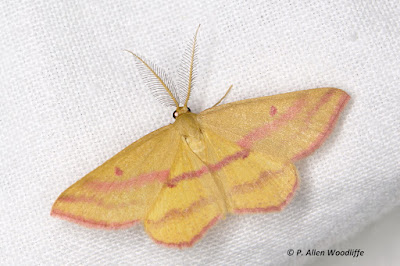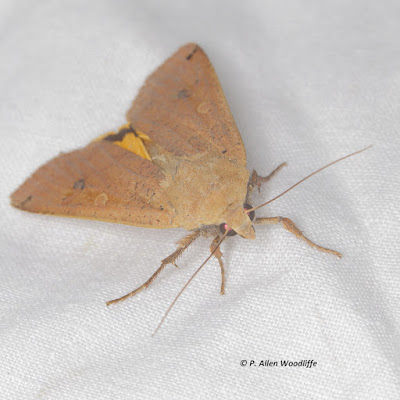On our continuing tomato plants was this Tobacco Hornworm, the larval form of the Carolina Sphinx Moth.
The 'horn' at the tail end is where it gets part of its name.
On some late flowering goldenrod were a number of wasps, but they were more interested in sipping the nectar than they were about my camera lens bearing down on them at close range.
 |
| Northern Paper Wasp (Polistes fuscatus) |
 |
| Spotted Beet Webworm |
It is interesting to see the chrysalis case turn clear, showing the folded up adult inside. When it gets to this stage, it is typically ~24 hours until the adult emerges, usually within an hour or two of first daylight.
The frustrating thing is that the actual emergence can happen in as little as a minute or even less! There has been more than one occasion when I was keeping a close eye on the chrysalis only to step away for perhaps less than 10 minutes and when I returned, it was out with partially opened wings. But for those who have watched this more successfully, it is said to take less than a minute, sometimes no more than 30 seconds. The wings begin to unfold shortly after emergence.
Eventually the wings are fully extended, and the butterfly spends an hour or two waiting for the fluid it has pumped into the wings to dry and harden, allowing the stiffness required for flight.
After this Monarch finally got its wings spread and dried and ready to fly, it took flight for a ways only to return and land on my shirt. After a minute or so, it then flew off for good. Although it seems a tad late for this stage of monarch life, there are still some in the chrysalis even now. My next door neighbour had a caterpillar on one of several milkweed plants in his yard up until a few days ago, and now has a chrysalis hanging on a wire beside the house. It has been in that form for about a week. I check it every morning, and it could emerge any day now.
Blacklighting after dark is always an adventure. Each time is different. On this occasion when I had the light set up in the back yard for about two hours, it was great to see such diversity of insects arrive at the white sheet. One of the most peculiar critters was this Nut or Acorn Weevil (Curculio sp).
 |
| Chickweed Geometer (Haematopis grataria) |
 |
| Crane Fly |
 |
| Dingy Cutworm (Feltia jaculifera) |
| Greater Black Dart (Xestia dolosa) |
I had seen the following things in the garden earlier, but didn't know at the time what left them. They are the eggs of a Green Lacewing.
 |
 |
| Large Yellow Underwing (Noctua pronuba) |
This next one is anything but rare. It is the Striped Cucumber Beetle (Acalymma vittatum).
Although insect activity is winding down as the weather approaches more normal condition, undoubtedly there will be more opportunities to capture some late season critters on digital film....stay tuned!















It is interesting what can find in the backyard. Nice find with the Round-tipped Conehead!
ReplyDeleteThanks, Blake....it is always different, and one never knows for sure. Every once in awhile something may turn out to be more significant.
Delete